Related Research Articles
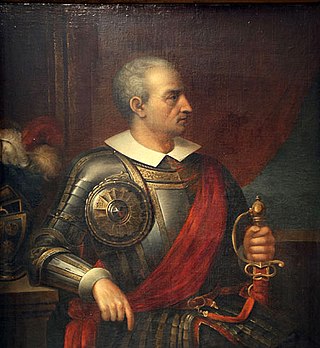
Diego de Almagro, also known as El Adelantado and El Viejo, was a Spanish conquistador known for his exploits in western South America. He participated with Francisco Pizarro in the Spanish conquest of Peru. While subduing the Inca Empire he laid the foundation for Quito and Trujillo as Spanish cities in present-day Ecuador and Peru respectively. From Peru, Almagro led the first Spanish military expedition to central Chile. Back in Peru, a longstanding conflict with Pizarro over the control of the former Inca capital of Cuzco erupted into a civil war between the two bands of conquistadores. In the battle of Las Salinas in 1538, Almagro was defeated by the Pizarro brothers and months later he was executed.
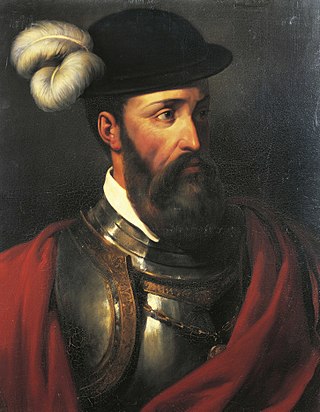
Francisco Pizarro, Marquess of the Atabillos was a Spanish conquistador, best known for his expeditions that led to the Spanish conquest of the Inca Empire.

Pedro Gutiérrez de Valdivia or Valdiva was a Spanish conquistador and the first royal governor of Chile. After serving with the Spanish army in Italy and Flanders, he was sent to South America in 1534, where he served as lieutenant under Francisco Pizarro in Peru, acting as his second in command.

Francisco de Orellana Bejarano Pizarro y Torres de Altamirano was a Spanish explorer and conquistador. In one of the most improbably successful voyages in known history, Orellana managed to sail the length of the Amazon, arriving at the river's mouth on 24 August 1542. He and his party sailed along the Atlantic coast until reaching Cubagua Island, near the coast of Venezuela.

The Chilean Navy is the naval warfare service branch of the Chilean Armed Forces. It is under the Ministry of National Defense. Its headquarters are at Edificio Armada de Chile, Valparaiso.
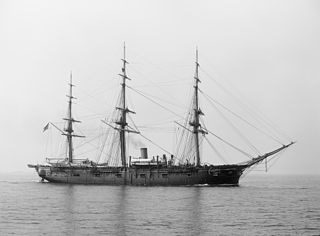
The first USS Lancaster was a screw sloop-of-war in the United States Navy during the American Civil War through the Spanish–American War.

Hernando Pizarro y de Vargas was a Spanish conquistador and one of the Pizarro brothers who ruled over Peru.
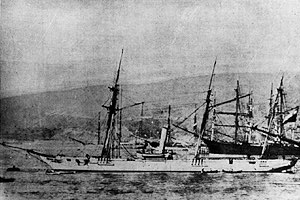
The schooner Virgen de Covadonga was a ship that participated in the Chincha Islands War and the War of the Pacific, under Spanish and Chilean flags. She was launched in 1859. Covadonga hit a floating mine and sank off Chancay in 1880.

Bahia Wulaia is a bay on the western shore of Isla Navarino along the Murray Channel in extreme southern Chile. The island and adjacent strait are part of the commune of Cabo de Hornos in the Antártica Chilena Province, which is part of the Magallanes and Antartica Chilena Region.

HMS Hecate was a Royal Navy 18-gun Cruizer-class brig-sloop, built by John King at Upnor and launched in 1809. After serving in the British Navy, essentially entirely in the East Indies, she served in the Chilean Navy as Galvarino from 1818 until she was broken up in 1828.
Francisco Hudson Cárdenas was a Chilean naval officer and hydrographer notable for his explorations of Southern Chile and Chilean Patagonia. Hudson sailed on behalf of the Chilean government several times to Peru and Ecuador, assisted the German immigrants arrive to Valdivia but gained notoriety for his explorations and investigations of Maullín River, Roca Remolinos and the channels of Aysén Region. Hudson was interested in investigating the possible existence of a sailing route through internal waters from the Chiloé Archipelago to the Straits of Magellan, but came to realize that the Isthmus of Ofqui made this impossible. However his hydrographic works laid the groundwork for Hans Steffen's exploration of Aysén Region in late 19th century.

Comet was an 1851 California clipper built by William H. Webb which sailed in the Australia trade and the tea trade. This extreme clipper was very fast. She had record passages on two different routes: New York City to San Francisco, and Liverpool to Hong Kong, and beat the famous clipper Flying Dutchman in an 1853 race around the Horn to San Francisco.
Independencia was a 26-gun corvette of the First Chilean Navy Squadron.

Chacabuco was a 20-gun corvette of 450 tons built in 1815 in Boston, USA. She came to Coquimbo as Avon where investors in Copiapó, Chile, purchased her to use her as privateer vessel under the name Coquimbo. But as the businessmen drew back, the Chilean government bought the ship on 20 June 1818 for $36,000. She was renamed Chacabuco and commissioned to the Navy under the command of Captain Francisco Díaz.
Meteoro was a brigantine of the Chilean Navy originally built in New Orleans for the Mexican Navy prior to the Mexican–American War. During its service in the Chilean Navy the ship engaged in the suppression of the Mutiny of Cambiazo in the Straits of Magellan. In 1859 Meteoro, commanded by Martín Aguayo, almost sunk at during a storm in Cape Horn while its companion ship Pizarro commanded by Francisco Hudson was lost.
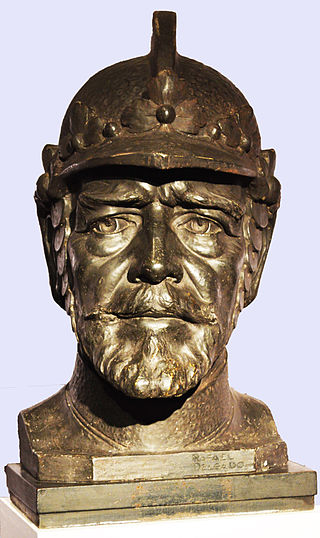
Juan Núñez de Prado was a 16th-century Spanish conquistador who is known for his conquest of Tucumán Province in what is now Argentina.

Palmenia del Carmen Pizarro González, better known as Palmenia Pizarro, is a Chilean singer.

Hurricane was a large extreme clipper of 1608 tons burthen built in Hoboken, New Jersey, United States in 1851. Reputedly the most extreme clipper ever built, Hurricane proved a very fast vessel, reportedly capable of speeds of up to 18 knots (33 km/h) in ideal conditions, and establishing a number of record passages in the early years of her career.

The Governorate of Terra Australis or Governorate of Pedro Sancho de la Hoz was a Spanish Governorate of the Crown of Castile created in 1539 which was granted to Pedro Sánchez de la Hoz and consisted in all the territories to the south of the Strait of Magellan until the South Pole, and, to the east and west, the borders were the ones specified in the treaties of Tordesillas and Zaragoza, respectively.
Santa Claus was an American medium clipper ship built in Boston by Donald McKay in 1854. In the course of her career, she made three voyages from the East Coast of the United States to San Francisco, California, the fastest of which was a comparatively swift 128-day passage in the winter of 1857–1858. The ship was mainly engaged in the guano trade and in trade to the Far East. In 1858, she brought Chinese immigrants to California; according to one source, she was also at one time engaged in the coolie trade.
References
- 1 2 3 4 5 Pizarro, bergantín Archived 2014-05-08 at the Wayback Machine , Armada de Chile. Retrieved on 15 March 2013.
- ↑ Sepúlveda Ortíz, Jorge (1998), "Francisco Hudson, un destacado marino poco conocido en nuestra historia" (PDF), Revista de Marina (in Spanish): 1–20